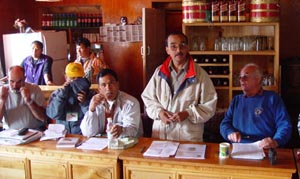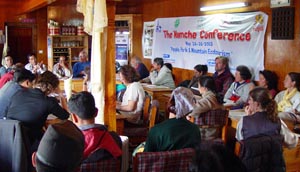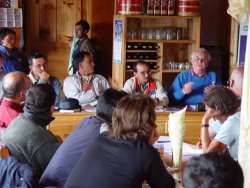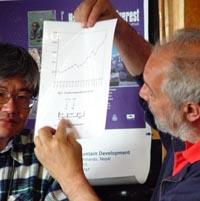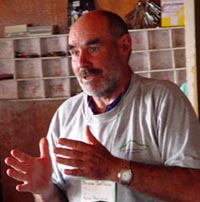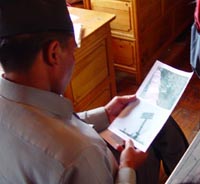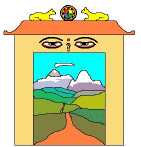
|
The Namche Conference: May 24-26,
2003
Sessions Report |
Session 1. State of the Park: Progress, Problems and Opportunities in and around Sagarmatha National Park
Deforestation, Pollution, and Sustainability of Sagarmatha National Park Dr. Basnet reported on research conducted in the early 1980s and published in three papers in the 1990s. He compared and contrasted problems perceived at that time with those that are emerging today. Deforestation was perceived as a major issue, not only in SNP but globally. Later research showed that deforestation was not the major problem, because the process started even before the Sherpas arrived in 1500. Pollution also was considered a major problem in the 1980s, before the beginning of the cleaning campaigns. Tourism was considered a problem because of its relation to deforestation and pollution. Deforestation of course occurs wherever people settle, but in this area the impact was different from what occurs in the lowlands and middle mountains. First, the available agricultural land in Khumbu is limited: most of the area is covered of ice. Secondly, most of the people in Khumbu are living on agricultural land but involved in tourism. Third, there was no electricity: the Thame power plant had been under construction but was washed away by the Dig Tsho GLOF event in 1985. Everybody used firewood, including tourists who used it for hot showers. Even now, looking at the woodpiles along the trail, we can see that energy demand is a major contributor to deforestation. Pollution is also increasing because of tourism. In the 1980s, everywhere you could see the trashes and garbage. The main area of pollution was the Base Camp at that time, and Kala Pattar. The density was really high: there was like 75 bottles per square meter during that time, and also in every four meter at least you see at least one or two bottles surveyed along this route. Despite the efforts of the SPCC, and all that has been accomplished, you can still see the problem. An important factor in the problem has been the increase in tourism traffic, from 642 in 1971-72, to 5000 per year in the 1980s, to more than 15,000 in 1990, reaching more than 25,000 in 1999. In order to manage the park sustainably, we must look at this tourism issue.
Let There Be Light Mr. Freake began his presentation by explaining that the latest project is trying to introduce electricity in Phortse village, Khumbu District, Nepal. In 1989, after a climbing expedition and first visit to the village of Phortse, Freake responded to a request from the villagers: to build a hostel for the teachers of the local school, who at that time were actually living in the school, sleeping on the floor. Later he was asked to undertake construction of a clinic. The doctors at Kunde agreed that it would be useful to have an outpost in Phortse. Money for these first two projects was at first raised locally. Then Freake was contacted by the John Vessy, headmaster at Eton College, who proposed to have a group of students assist in construction on a volunteer basis; in exchange, Eton would help raise money. The actual construction was contracted out to a local carpenter, Pasang Lama, who had worked for the Himalayan Trust. Meanwhile, one of the Eton boys, Gordon Daniels, died as a result of a stunt in the course of a fund-raising effort; afterwards, more money was raised in the name of Gordon Daniels, as the entire school became involved, not just the mountaineering club. Freake recounted another request: to appoint a new health officer. It seems that the Himalayan Trust had appointed a certain man, who, on getting fed up with the job, had simply turned it over to his brother, a yak-herd with no medical experience at all. As he was generally absent, his family handed out medicine indiscriminately, and recently two babies had died unnecessarily of dysentery. Freake held a town meeting in Phortse, and the result was the appointment of a “lovely lovely lady from the village, and she’s doing a marvelous job there.” After completion of the clinic, Freake was requested to built a gompa. Despite lack of religious or architectural expertise, Freake adapted the design of Tengboche Monastery. Faced with an estimate of 20,000 pounds. However, John Vessy, on behalf of the Phortse trust, requested assistance from Gordon Daniel’s father. “I think this is what my son would have wished,” he said, and gave the necessary funds. After that, Freake built a school at Phortse, again with the assistance of the Eton school. There was no heating, but each room was painted in a different pastel color, and it was the only school in Khumbu with a carpeted floor – as one Eton lad remarked, “This is not a school, it’s a Wendy house!” [A Wendy house is a children’s playhouse.] Freake concurred: it’s a place where children can play as well as study. There are now three new schoolteachers, one of whom is actually from Phortse. Freake has been assisting one of the students, who has progressed through the university and has recently been staying with Freake’s family in the UK; he hopes that she will one day return and take over the school. The prior schoolhouse was transformed into a youth center, and Freake procured a couple of ping-pong tables from Kathmandu. (“I suggest you don’t challenge the lads to table tennis!”) He also got a telephone for the village. Now Freake is planning to introduce electricity, which he thinks might reduce deforestation by 40-50%; and following that, he wants to pipe water into each house, so that the children will not have to carry it in from a tap outside the village.
An Approach to Monitoring and Assessing Ecosystem Health in the Khumbu Valley Professor Caravello and his team began this study at the Pyramid (near Lobuche) in 1992; quite a bit of data had been collected about water quality and also about human health, and there was an interest in applying this data to the evaluation of ecosystem health. The premise is that good human health is an indicator of good ecosystem health, and vice versa, or more broadly: economic, human and biophysical “health” must be connected.
Natural Environment and People Living the World Heritage Sites: Khumbu and Shrirakami (Japan)
Since 1953, Sherpa society has been in economic and social contact with the rest of the world through the mountaineering and trekking industries. In 1979, SNP was declared a World Heritage Site. Since them, the number of foreign tourists has increased sharply, surpassing by far the number of residents. Many Sherpas have left Khumbu. both seasonally and permanently, seek employment in the trekking and mountaineering industries. The number of Sherpas involved in agriculture and animal husbandry has decreased. A similar pattern has occurred in remote areas of Japan since World War II. With rubbish and excrement, the numerous outsiders have caused damage to the narrow enviroment along the roads. Several programs have been undertaken to counter this trend. In 1993, the Shrirakami Mountains (Horseshoe Islands, northern Japan) were declared a natural World Heritage Site. Depopulation has occurred there, as in the Sherpa homeland. Many villagers have been displaced as a dam is being reconstructed and nearly 200 homes will soon be flooded. Some local people have sought employment as ecotourism guides. However, ecotourism is leading to destruction of the natural environments. Similarly, trekking is leading to the destruction in Nepal. If nature is assessed only on the basis of their commercial potential, more damage will occur. Park management and local communities must collaborate to sustain the natural environment.
Sagarmatha National Part and Ecotourism: A Challenge Dr. Aryal defined sustainable tourism as tourism which gives something back to the community’s environment and economy; it can be maintained and will deliver benefits over a long period of time. Previously, SNP was badly affected by tourism. Many hotels and teashops were constructed, which, along with the consumption of huge amonts of biofuel, put pressure on the forests. Pollution, in the form of human waste, trash, and abandoned mountaineering equipment, was a serious problem. Wildlife, consuming food abandoned in the trash, especially by trekkers (on whom no guidelines have been imposed) as well as by lodges, threaten human health. Human waste has polluted drinking water sources. Aryal divides the challenges into three issues: deforestation, waste management, and wildlife trade. Deforestation has been to some degree controlled by the park management, but at higher elevation, the use of biofuels continues. Lodges, households, and especially porters continue to cut trees. Aryal notes that in the shops of Namche, skins and products of protected animals are openly sold; these include pelts and ivory. Though local people maintain that the products are imported from Tibet, the trade is a significant problem. Another issue is that of unauthorized climbers, who climb without permits and who do not follow prescribed guidelines.
Sagarmatha National Park: A World Heritage Site in Danger or a Figment of a Western Imagination? Mr. Jeffries was involved in the original negotiation to have the Sagarmatha National Park declared a World Heritage Site in 1979 – he looks back now with the perspective of some 25 years and finds that the state of the park has deteriorated to the point where, while it is not necessary to necessarily have the designation of World Heritage Site revoked but where it is now necessary to send up some warning signs. He justifies his observations even as a foreigner on the basis of the fact that World Heritage Sites do indeed belong to the entire world.
To corroborate his observations, Bruce handed out several pictures about activities (such as illegal logging) and landscape (deforestation) in the park. The audience was shocked with the images. “The park needs deep surgery, not Band-Aids.”
|
